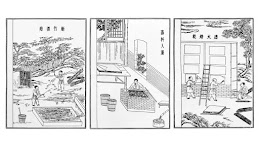I’ve never really considered paper a type of technology, so researching it was actually pretty interesting. The word paper derives from papyrus, a reedy plant that grows along the Nile River in Egypt. In ancient times, the fibrous layers in papyrus stems were removed and then crossed at right angles with another set of similarly arranged layers. After being dampened and pressed, the drying initiated the gluelike sap of papyrus to act as an adhesive. This process cemented the layers together, forming pieces of “paper.” Back then, papyrus was the most popular writing material, and many records still survive today.
Back then, pieces of bamboo or silk strips were utilized to trace writings and inscriptions. However, the heaviness of bamboo and the costliness of silk kept them from ever being used conveniently. Cai Lun began making paper from various natural materials such as tree bark, hemp waste, old rags, and fishnets. These ingredients were all pounded down to be mixed in water before spreading it flat to dry. There were many experiments with different fibers to make paper to find the cheapest mix of materials that produced the highest quality.
 |
| Papermaking Process Outlined by Cai Lun |
Paper was soon taken beyond being just a technical invention through its successful innovation. The overall quality of paper significantly increased near the end of the Han period (206 BC-220 AD), spreading it quickly through the empire and soon traded to foreign states along the Silk Road.
 |
| The Connectivity of the Silk Road |
There are some negative effects of paper, specifically environmental ones. These include deforestation and the vast amounts of energy used to produce paper. In 2018, the largest component of municipal solid waste (MSW) was paper and cardboard. The total amount of these materials combusted was over 4 million tons, making it 12.2% of all MSW that year. Paper cuts are also considered a negative effect of paper creation in my book.
 |
| Global Paper & Cardboard Production Volumes 2008-2018 |









No comments:
Post a Comment